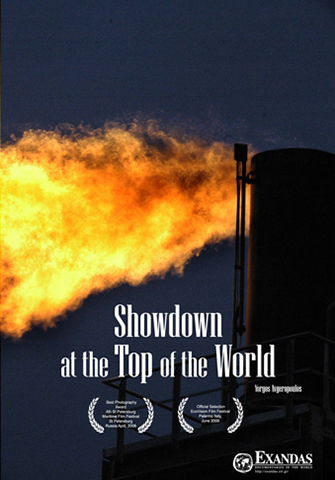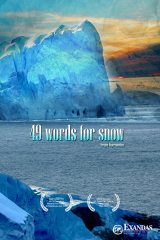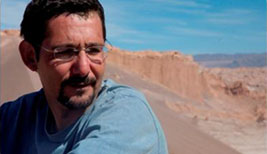
Showdown at the Top of the World
Dir: Yorgos AvgeropoulosThe Arctic Ocean spreads across 14 million square kilometers and conceals 25% of the global oil and natural gas reserves. As the ices melt, bays, marine areas and islands that had been long forgotten suddenly find themselves in the spotlight of the international agenda.
Five arctic states, Russia, Canada, Norway, Denmark and the US, lay claims to a piece of the Arctic and, of course, to the largest share of the treasure. The film explores the economic and geostrategic facts of the Great Arctic Game that has just begun.
Watch the Film Now!
Choose the language you prefer and stream the film in Full HD from any digital device. Enjoy your private screening!
Buy the DVD
Public Screening
Are you interested in organizing a public screening of our film? Send us an email with your inquiry and we will be glad to assist you!
Educational / Library Use
Are you interested in enriching the library of your institution with our film? Contact us and let's create together an informed public!
- DURATION: 57min
- AVAILABLE IN THE FOLLOWING LANGUAGES: English | Greek
- AVAILABLE VERSIONS: English (57min) | Greek (57min)
- YEAR OF PRODUCTION: 2008
- Written & Directed by: Yorgos Avgeropoulos
- Recearch by: Georgia Anagnou
- Production Manager: Anastasia Skoubri
- Director of Photography: Yiannis Avgeropoulos
- Editing: Yiannis Biliris, Meletis Pongkas
- Original Music by: Yiannis Paxevanis
- Fixing: Anton Verstakov
- Graphics: Sakis Palpanas
BEST PHOTOGRAPHY PRIZE
5th International Science Film Festival
St. Petersburg, Russia
April 2008
PRODUCTION NOTES
The Arctic Ocean spreads across 14 million square kilometers and conceals 25% of the global oil and natural gas reserves. As the ices melt, bays, marine areas and islands that had been long forgotten suddenly find themselves in the spotlight of the international agenda. Five arctic states, Russia, Canada, Norway, Denmark and the US, lay claim to a piece of the Arctic Pole and, of course, to the largest share of the treasure. This is a new-age western film on the Wild North, which explores the economic and geostrategic facts of the Great Arctic Game that has just begun.
Following “49 Words for Snow” which received very positive comments by both audiences and Press, Exandas completes its climate special with “Showdown at the Top of the World”. This is a new-age western film on the Wild North, which explores the economic and geostrategic facts of the Great Arctic Game that has just begun.
In the context of a rare -by Greek standards- production, collaborators of “Εxandas Documentaries Series” travel in three countries north of the Arctic Circle so as to thoroughly record the setting of the modern “cold war”.
Filmed in Russia, Canada and Norway, “Showdown at the Top of the World” manages to reach key-locations and meet the protagonists of the actual events, at the time that they are happening.
RUSSIA
Artur Chilingarov is a top Russian explorer and politician, the man who led a Russian mission at the bottom of the North Pole, a mission that attracted interest on a world scale last summer. Then, two manned submarines put a Russian flag made of titanium in 4.000 meters depth, bringing Russia back to the world scene dynamically. And gaining, if anything, an impressive edge in the race for the Arctic.
“Just as the Americans put their flag on the moon, so did we at the bottom of the Arctic”, says Chilingarov smiling beneath his rich beard. “It’s made of titanium, it will stand there for as long as we want. It’s natural for the other countries to worry. We have the only fleet of ice-breakers in the world. We can reach any spot on the north Arctic Ocean. I, as a Russian explorer and politician, want to see Russia expanding as much as it is possible in the Arctic and the North, as everything, oil, natural gas, diamonds and gold are there.” The warnings of scientists and ecologists regarding the environmental dangers that lie in the industrialization of the Arctic leave Mr. Chilingarov utterly indifferent. “We will not live long enough to see it”, he answers bluntly.
The Russian key to the exploitation of the Arctic treasure is Murmansk. Port of strategic importance both for trade and for the military presence of the super-power in the North, it has declined after the collapse of the Soviet Union.
Now however, the town looks ready to turn into the “Polar version” of the rich in oil Arab countries. Out at sea, at the bottom, one of the biggest natural gas deposits in the world has been located. Τhe Shtokman deposit is so big it is enough to cover all of the European Union’s needs in natural gas for seven years. Τhe executives in Gazprom, the Russian colossal oil company, rejoice. Any question regarding the environment falls flat in front of the value of the deposits that exceeds the amount of 400 billion dollars. “We are aware that human activity is possibly dangerous, but stopping our economic growth, we cannot allow”, they say. Τhe deposits were discovered in 1988, but remained unexploited due to extreme weather conditions and the depth of the sea. Both these problems however, seem to have been overcome now. The climate changes, while in nearby Norway oil company Statoil has already developed the technology needed for the mining of the Arctic seas.
ΝORWAY
“Snohvit” will go down in history as the first installation for fuel mining from the Arctic. This is what the industrial complex that has been set up in the most northern town in the world, Hammerfest in Norway, is called. Its operation started only in September 2007 and it draws natural gas from the bottom of the sea. Τhe deposit is 150 km away from the town and the extreme polar conditions made the use of traditional floating devices impossible. This is why, in order to be able to exploit it, Statoil oil company developed a novelty method: it constructed underwater pumps that sucked the gas from underground and sent it with pipelines of 150 km. to the land for processing.
Hammerfest, from a quiet fishing community, has become an industrial town. It’s the Klondike of the Wild North, where thousands of people from around the world, like new gold-diggers, arrive to work in the new industry and “make it”. The residents are happy to watch their town transform and develop financially, despite the fact that the factory is set in a very close distance from their homes. Despite the fact that the huge flames of the chimney have turned the sky into orange and when it rains, ash and smoke cover houses and streets. “An atmosphere has come about where nobody can judge the program because it would be as if they betrayed the Hammerfest community”, says journalist Helle Ostvik who, censoring herself, writes only positive commentary in the local paper. “It is awful, we are at the mercy of a company which is so good in informing people in a way most convenient to them.”
CANADA
American businessman Pat Broe bought a port from the Canadian government in 1997. Τhe arctic port of Churchill in Northern Canada. The price he paid is unbelievable: 7 American dollars! Mr.Broe might have been perceptive or not, anyway though, he has every reason to be happy. Now that the ice melts and new marine ways are being opened, the port might bring him more than 100.000.000 dollars profit per year.
The beginning was when, for the first time in history, Europe was connected with the American continent through the Arctic seas. The line was inaugurated by cargo ship “Capitan Sviridov” and the camera of Exandas was there recording the historic event.
There are 800 people and 300 bears living in Churchill today. The community lives off tourism as hundreds of people from around the world come to the “Capital of the Polar Bear”, as the city is otherwise known, to admire the arctic mammals from up close. Due to the climate change their population is reducing, but this doesn’t seem to bother anyone. The residents see that they will make more if the port develops. “Climate change is a very big opportunity for us, it is a big opportunity and we will take advantage of it to the extreme”, the representatives of the company that owns the port tell us. “The melting of the ice is a very good opportunity. Chances emerge that we are going to take advantage of because we want to be on the winners’ side.”







